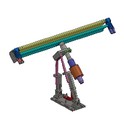Ultrasonic cleaning is a widely recognized and effective method for a variety of cleaning tasks. As an ultrasonic cleaning supplier, I often receive inquiries about the suitability of ultrasonic cleaning for different materials, and one common question is whether ultrasonic cleaning can be used for cleaning ceramic items. In this blog, we will explore the science behind ultrasonic cleaning, its potential benefits and limitations when it comes to ceramic items, and provide some practical considerations.
How Ultrasonic Cleaning Works
Before delving into its application on ceramic items, it's essential to understand the principle of ultrasonic cleaning. Ultrasonic cleaning relies on the phenomenon of cavitation. When high - frequency sound waves (usually in the range of 20 kHz to 400 kHz) are transmitted through a cleaning solution, they create alternating high - and low - pressure cycles. During the low - pressure phase, tiny bubbles, or cavities, form in the liquid. When these bubbles reach a certain size, they collapse violently during the high - pressure phase. This collapse generates intense shockwaves and micro - jets of liquid, which can dislodge dirt, grease, and other contaminants from the surface of the object being cleaned.
Benefits of Ultrasonic Cleaning for Ceramic Items
Thorough Cleaning
One of the primary advantages of using ultrasonic cleaning for ceramic items is its ability to achieve a thorough clean. Ceramics can accumulate dirt, grime, and even stubborn stains over time, especially in hard - to - reach areas such as crevices and pores. The cavitation effect of ultrasonic cleaning can penetrate these areas and remove contaminants that might be difficult to access with traditional cleaning methods. For example, ceramic vases with intricate designs or ceramic figurines with small details can be effectively cleaned using ultrasonic technology.
Non - Abrasive
Ultrasonic cleaning is a non - abrasive process, which is crucial for delicate ceramic items. Unlike scrubbing with brushes or using abrasive cleaning agents, ultrasonic cleaning does not scratch or damage the surface of the ceramic. This makes it suitable for cleaning antique or valuable ceramic pieces that require gentle treatment.
Efficiency
Ultrasonic cleaning is relatively fast compared to manual cleaning. Once the ceramic item is placed in the ultrasonic cleaning tank filled with an appropriate cleaning solution, the cleaning process can be completed in a matter of minutes to hours, depending on the level of contamination. This efficiency can be beneficial for businesses or individuals who need to clean multiple ceramic items in a short period.
Considerations When Using Ultrasonic Cleaning for Ceramic Items
Material and Structure of the Ceramic
Not all ceramic items are suitable for ultrasonic cleaning. Some ceramics may have a porous structure that can absorb the cleaning solution, leading to potential damage or discoloration. For example, unglazed or highly porous ceramics may be more prone to this issue. Additionally, ceramic items with loose parts, such as ceramic jewelry with glued - on components, may be at risk of having the parts dislodged during the ultrasonic cleaning process.
Cleaning Solution
Choosing the right cleaning solution is crucial when using ultrasonic cleaning for ceramic items. The solution should be compatible with the ceramic material to avoid any chemical reactions that could damage the surface. Mild detergents or specialized ceramic cleaning solutions are often recommended. It's also important to follow the manufacturer's instructions regarding the dilution ratio and usage of the cleaning solution.


Frequency and Power
The frequency and power of the ultrasonic cleaning system can also affect the cleaning process. Different frequencies may be more effective for removing different types of contaminants. For general cleaning of ceramic items, a frequency in the range of 40 kHz to 60 kHz is often suitable. However, it's advisable to start with a lower power setting and gradually increase it if necessary to avoid over - cleaning or damaging the ceramic.
Our Ultrasonic Cleaning Products for Ceramic Items
As an ultrasonic cleaning supplier, we offer a range of high - quality ultrasonic transducers that can be used for cleaning ceramic items. Our ResoRod - 35 - H Ultrasonic Transducer for Cleaning is designed to provide a consistent and powerful ultrasonic output. It operates at an optimal frequency for effective cleaning of various materials, including ceramics. The transducer is durable and can withstand continuous use, making it suitable for both small - scale and large - scale cleaning operations.
Another option is our ResoRod - 25 - H Ultrasonic Transducer for Cleaning. This transducer is more compact and energy - efficient, making it a great choice for home users or small businesses that need to clean a limited number of ceramic items. It still provides excellent cleaning performance and is easy to install and operate.
For those who require a more powerful and versatile solution, our ResoRod - 30 Ultrasonic Transducer for Cleaning is an ideal option. It offers a wider range of frequency adjustment, allowing users to customize the cleaning process according to the specific requirements of the ceramic items.
Conclusion
In conclusion, ultrasonic cleaning can be a viable option for cleaning ceramic items, offering thorough, non - abrasive, and efficient cleaning. However, it's important to consider the material and structure of the ceramic, choose the right cleaning solution, and select an appropriate frequency and power for the cleaning process. As an ultrasonic cleaning supplier, we are committed to providing high - quality products and professional advice to ensure that our customers can achieve the best cleaning results for their ceramic items.
If you are interested in our ultrasonic cleaning products for ceramic items or have any questions about ultrasonic cleaning, we encourage you to contact us for a procurement discussion. We are happy to assist you in finding the most suitable solution for your needs.
References
- Povey, M. J. W. (2005). Industrial Ultrasonics: Technology, Methods, Applications. CRC Press.
- Mason, T. J., & Lorimer, J. P. (2002). Applied Sonochemistry: Uses of Power Ultrasound in Chemistry and Processing. Wiley.
- Various industry reports on ultrasonic cleaning technology and its applications.






